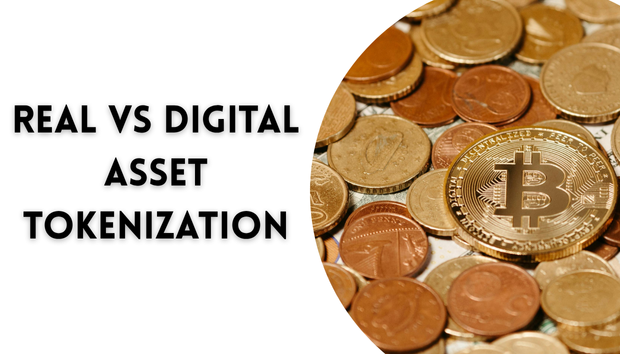Tokenization is an emerging paradigm of ownership in the blockchain space that is changing ownership, tradability, and management around assets. There is an ability to create that is taking physical assets and tokenizing them into digital tokens on a blockchain. This process of tokenization adds verifiability, speed, and the concept of liquidity to conventional ways of investing in and owning assets. And, while there are many benefits and opportunities with tokenization, we realize, they come with their own set of pitfalls, through the misunderstanding of tokenization, and similar concepts like project securitization.
Tokenization primarily falls into two categories: Real Asset Tokenization and Digital Asset Tokenization. While they both are embraced as tokenized assets under the blockchain space, they differ widely in terms of what is being tokenized, the tokenization process, regulatory perspective, and implications for investors and markets.
What is Tokenization?
Tokenization involves transforming the ownership rights of an asset into a digital token secured on a blockchain. This digital token is traded or held like any other digital asset, and is based on real value, or in some cases, virtual value.
For example,
A token representing a share in a physical building would be a tokenized real asset. A token representing a portion of a digital artwork or cryptocurrency would be considered a tokenized digital asset.
What is Real Asset Tokenization?
Real asset tokenization is the representation of a physical, tangible asset on a blockchain. Physical assets may include, but are not limited to:
- Real estate properties
- Gold, silver, and other commodities
- Art
Tokens representing fractions or ownership of actual physical assets are always linked to physical assets. Typically, ownership is enforced on the blockchain through smart contracts.
Example: A commercial property worth $1 million could be subdivided into 100,000 tokens. Each token could represent a 0.001% interest in the property and allow investors to invest without buying the whole property.
What is Digital Asset Tokenization?
Digital asset tokenization is the process of issuing blockchain tokens with native digital assets as their collateral. Digital assets can include:
- Cryptocurrencies like Bitcoin or Ethereum
- NFTs (Non-Fungible Tokens)
- Metaverse assets (virtual land, avatars, etc.)
- In-game assets
- Digital intellectual property (music, videos, or code)
The asset is already in digital form. Tokenization is fragmenting the ownership or represents rights, access, and/or value transfer through programmable ownership.
Example: An artist creates a digital painting and mints it as an NFT to be sold on the blockchain. Each NFT could represent ownership of the original digital file or just proof of authenticity.
Upsides of Real Asset Tokenization
Fractional Ownership: Lower the total ownership cost of an expensive asset for small investors.
Liquidity: Convert a traditionally illiquid asset into tradable tokens.
Transparency: An Immutable record of ownership is readily accessible through the blockchain.
Reduction of Intermediaries: Smart contracts automate the transfer of ownership and reduce third-party services.
- Downsides of Real Asset Tokenization
- Legal and regulatory complexities.
- Custodial risks associated with physical asset management.
- Complexities of jurisdictional compliance.
Upsides of Digital Asset Tokenization
Programmability: Tokens may be embedded with smart contract logic for access, royalties, or utility.
Instant Transfer: Fast and secure peer-to-peer transactions.
Creative monetization opportunities: Creators can monetize digital content directly to consumers through NFTs or tokens.
Global access: Anyone with an internet connection and a wallet can own digital assets.
- Downsides of Digital Asset Tokenization
- Market volatility and market speculation.
- Lack of uniformity in regulation.
Use Cases for Each Type
Real Asset Tokenization Use Cases:
- Crowdfunded real estate investment platforms.
- Commodity-backed stablecoins.
- Art investment and ownership sharing.
- Fractional ownership of luxury assets like yachts or collectibles.
Digital Asset Tokenization Use Cases:
- NFT marketplaces for art, music and video sharing.
- Metaverse and interactive gaming ecosystems.
- Crypto lending and DeFi features.
- Token-gated communities and content access.
Future Outlook
Both real and digital asset tokenization are set to play critical roles in the evolution of the financial ecosystem. Real asset tokenization has the potential to bridge the gap between traditional finance and DeFi, offering new avenues for capital formation, particularly in sectors like real estate and commodities.
On the other hand, digital asset tokenization will continue driving innovation in entertainment, gaming, and virtual experiences, with NFTs, metaverse tokens, and blockchain-based content distribution models becoming more mainstream.
While real and digital asset tokenization share the same foundational technology—blockchain—their applications and implications differ greatly. Real asset tokenization democratizes access to physical wealth, making previously illiquid investments accessible to a broader audience. Digital asset tokenization, on the other hand, redefines ownership in the digital realm, enabling new forms of value creation and monetization. Understanding the difference between these two categories will be essential for investors, developers, and businesses looking to leverage blockchain for future growth.
